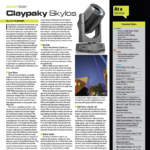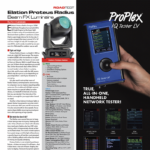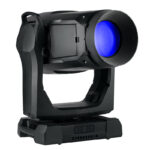Robe’s Robin MMX WashBeam incorporates some of the same elements as Robe’s previously introduced MMX Spot, including the use of Philips Platinum 35 lamp as the light source. But unlike the Spot, the WashBeam gives users two different lens options — a plastic Beam lens and glass Fresnel Wash lens. Only one can be installed at a time. The fixture is smart enough to tell which one is currently being used, and that changes the functions of some of the features found inside along with the beam coming out the front.
 The Lamp
The Lamp
Philips’ metal halide Platinum 35 lamp uses only 800 watts, but with its optical system, Robe claims that the WashBeam has an output comparable to a 1200W fixture. I put this claim to the test by adding the WashBeam to a rig with 1200W fixtures and, to my eyes at least, the WashBeam’s output kept up with the more power-hungry fixtures. A nice bonus of that energy efficiency is the ability to power the WashBeam with a standard 20 amp circuit — or for those who enjoy “living on the edge,” even a 15 amp circuit. The fixture as a whole draws less than 1,110W.
Fixing the Hot Spot
One thing I have always hated is taking the time to correct a fixture’s hotspot. Either you do it in the shop, on the ground before hanging the fixture or, more commonly for those of us who forget it from time to time, pulling out a ladder or lift and putting a screw driver to the back to fix it.
The WashBeam eliminates that pesky chore with Hot-Spot Control — a real time-saver that I fell in love with. The fixture has a control channel for adjusting the mirror within the fixture, right from the console. The only downside is that, once you set the Hot-Spot channel to the correct position via the control channel, there is no way to lock it in at the fixture itself. To overcome that little problem, however, there is an easy fix: just write a default preset, or adjust the fixture’s template in patch.
In most cases, adjusting the fixture’s template in patch will be the best solution, unless you have different levels for the Hot-Spot channel across multiple fixtures. Not a huge problem in the end, just something to think about before the programming session begins.
Controlling the Beam
Robe has stepped up to the plate with beam-shaping capabilities. In the WashBeam, the internal shutters are technically called barndoors. Call them what you like, either way, their speed of their movement is blazingly fast. You get four independent blades that basically work by moving in and out of the beam, there’s no blade-tilting here. But the entire barndoor assembly does offer 180 plus or minus rotation. For the speed that you get, I can deal without the independent tilt adjustment on the blades. They move so fast from in to out that you might think you accidentally started switching gobos.
There is an additional channel control for barndoor macros in the fixture. I have never been a big fan of macro channels on fixtures. The barndoor macro started to change my mind about that. One macro that I really enjoyed was the “bouncing square.” Sure, I could have built an effect to have a square bounce around the entire beam. Then I remembered, time is money, and it is just a macro channel away.
Hold the Focus and Zoom
The WashBeam has the same sort of features you would expect from a profile or beam fixture, including six rotating gobos plus open and a beam reducer on the gobo wheel in addition to zoom and focus functionality.
Depending on which lens you have installed on the front of the fixture, the zoom ranges from 3° to 65° (Beam mode) or 4° to 54° (Wash mode). The Stay Sharp control channel, a feature now making a headway in the industry, is another plus. In Beam mode, I was able to take a gobo in focus, set the Stay Sharp or AutoFocus channel to the distance the fixture was from where it was projecting, and zoom the fixture without losing the sharp focus of the gobo. Try programming that effect in any board, and you’ll be there all day.
 Color Me Up
Color Me Up
Color is a huge part of determining which fixture you may use. Robe has made the choice simple for users in regards to color. For static and super-saturated colors, you have a fixed six-color wheel. If mixing is your style (like mine) and you want those pastels, the WashBeam includes a CMY mixing system. To match the fixture to tungsten-based fixtures, the WashBeam also has a CTO module.
 Menu System
Menu System
Something that I have fallen in love with in all of Robe’s latest fixtures is the built-in touchscreen for the menu system. With all of the advanced controls and options available in their recent offerings, the old menu system, with just a Menu, Enter and Arrow Up or Down button is becoming archaic. Sure, those buttons are still there, but having the ability to simply touch the selection on the display makes configuring the fixtures quick and simple. To add to the ease of setup, the WashBeam also has the battery powered menu system found in all of the other fixtures in the Robin series. Configuring the fixture doesn’t require it to be plugged in.
Optional Wireless Control
Another feature that the Robin series of fixtures offers is the built-in wireless controller from LumenRadio. While I am still on the fence about wireless control, the addition of LumenRadio with the RDM functionality makes configuring and patching that much simpler. Configuring a Robin Series fixture over LumenRadio does require LumenRadio’s SuperNova software on a laptop connected to the network, but once you clear that hurdle, you’ll be able to test, patch and problem-solve without using a ladder or lift. It is all done on-screen from the comfort of FOH or while lounging at “Dimmer Beach.”
Two for the Price of One
Overall, I was impressed with the WashBeam fixture. Its features and controls allow for a wide array of different looks. I am still a little hesitant about the two different lens options that come with the fixture, however. You may get two types of fixtures out of one, but having to physically switch the lens seems a little awkward. For many, however, that bit of extra planning that will be required before the rig goes to hang will be a small price to pay for versatility.
The output is fantastic, along with the speed of the built-in features. The beam was even across the field in either mode. That is, after adjusting the Hot-Spot control. The speed of the pan and tilt was on par with typical fixtures in this size range — not super fast, but not slow either.
A Beam AND Wash Fixture
Pros: Two fixtures in one, super-fast barndoors, touchscreen menu system.
Cons: Choice of lenses adds to the ?pre-show rig prep checklist.
Fixture Size: 27.4”x 17.6”x 10.6”
Weight: 56.2 lbs.
Lamp Type: Philips Platinum 35 ?(metal halide, 800W)
Channel Count: 34, 29 or 27
Lens Options: Beam or Wash
Other Options: LumenRadio wireless controller built-in; can be operated via laptop software
Ports: 3pin & 5pin XLR in and out, RJ45
Price: $12,990



